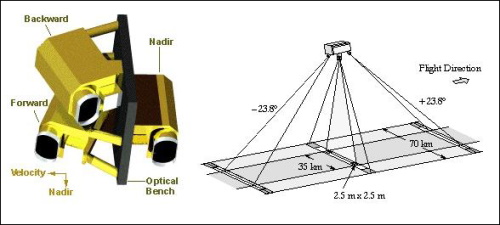PRISM Overview
The Panchromatic Remote-sensing Instrument for Stereo Mapping (PRISM) was a panchromatic radiometer with 2.5 m spatial resolution at nadir. Its extracted data was designed to provide highly accurate digital surface model (DSM).
The objective of PRISM was to obtain high-resolution stereo data (pixel size of 2.5 m) for cartographic applications (extraction of highly accurate digital elevation models, etc.).
The instrument was a "three-line imager" with three independent catoptric systems for nadir, forward and backward-looking to achieve along-track stereoscopy. Each of the three telescopes employed a three mirror type optics design (30 cm aperture diameter and 2 m focal length) and several CCD detectors for pushbroom scanning. Six or eight silicon CCDs (5,000 pixels each) were physically aligned at each telescope's focal plane. Of the 40,000 pixels per telescope, 14,000 pixels were electronically selected and transferred to the ground station. Thus, a triplet image consisted of three (fore, nadir aft-looking) 14,000 pixels/line.
The nadir-looking telescope provided a swath of 70 km width (28,000 readout pixels), each of the fore and aft-looking telescopes provides a swath of 35 km (14,000 pixels per band). The fore and aft telescopes were inclined by ±23.8° from nadir to realise a base to height/ratio of one at an orbital altitude of 692 km.
The PRISM optics were mounted on a rigid optical bench which is thermally controlled within ±3° C to minimise distortions in the optics system.
Instrument Sensor Modes

PRISM has the following sensor modes:
- OB1: Nadir, Forward, Backward views at 35 km width
- OB2: Nadir view at 70 km width and Backward view at 35 km width
Mission Operations
PRISM was programmed for repetitive, global-scale observations, and like AVNIR-2 and PALSAR, the observation strategy implemented aimed to maintain both spatial and temporal consistency over regional scales. The timing of the regional observations had been determined based on cloud statistics, seasonality and sun elevation, although cloud cover inevitably limited the amount of useful data acquired.
The default mode for PRISM operations is the 3-telescope triplet mode to enable along-track stereo viewing. As the swath width in triplet mode is 35 km, two 46-day cycles are required to achieve a full regional coverage, during which the instrument is tilted alternately (+/- 1.2° ) in across-track direction.
The PRISM plan can be summarised as follows:
- Odd cycle numbers: +1.2° viewing angle
- Even cycles: -1.2° viewing angle
Some area will be operated by 2-telescopes observing mode (nadir 70 km + backward 35 km) based on the users requirement.
For detailed views of which regions were scheduled for acquisitions by PRISM, please refer to the PRISM Acquisition Plan.